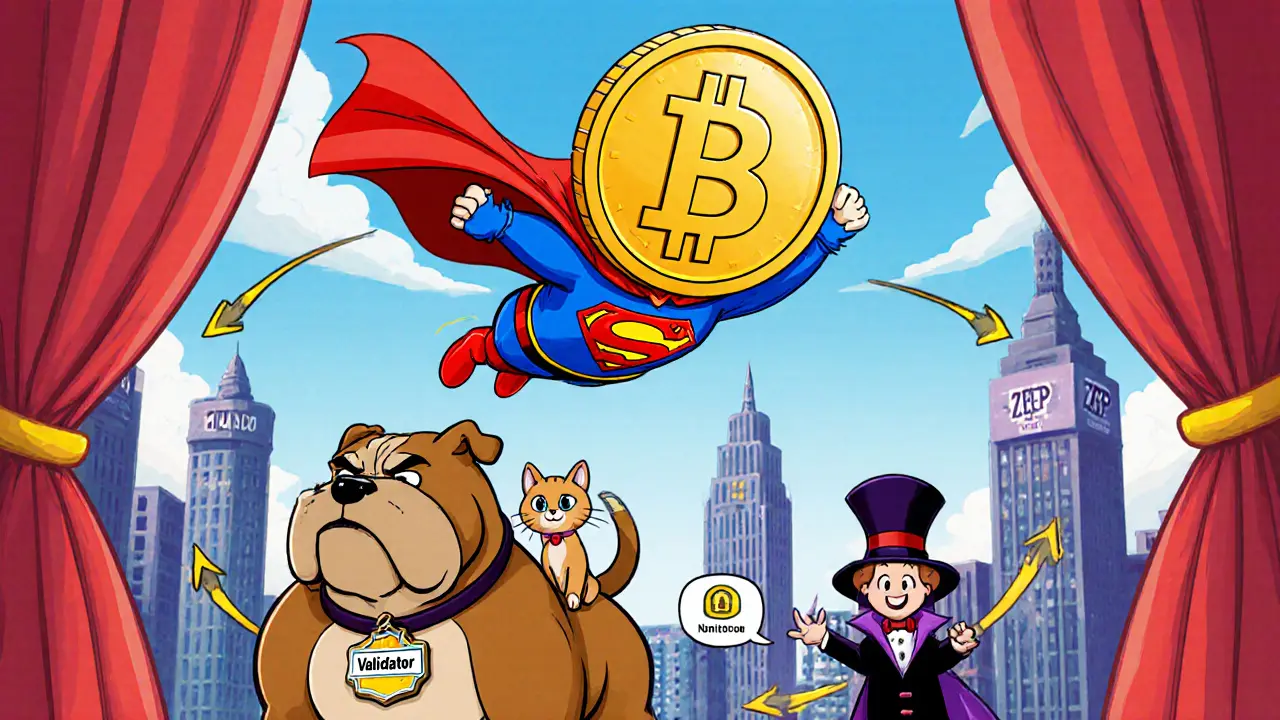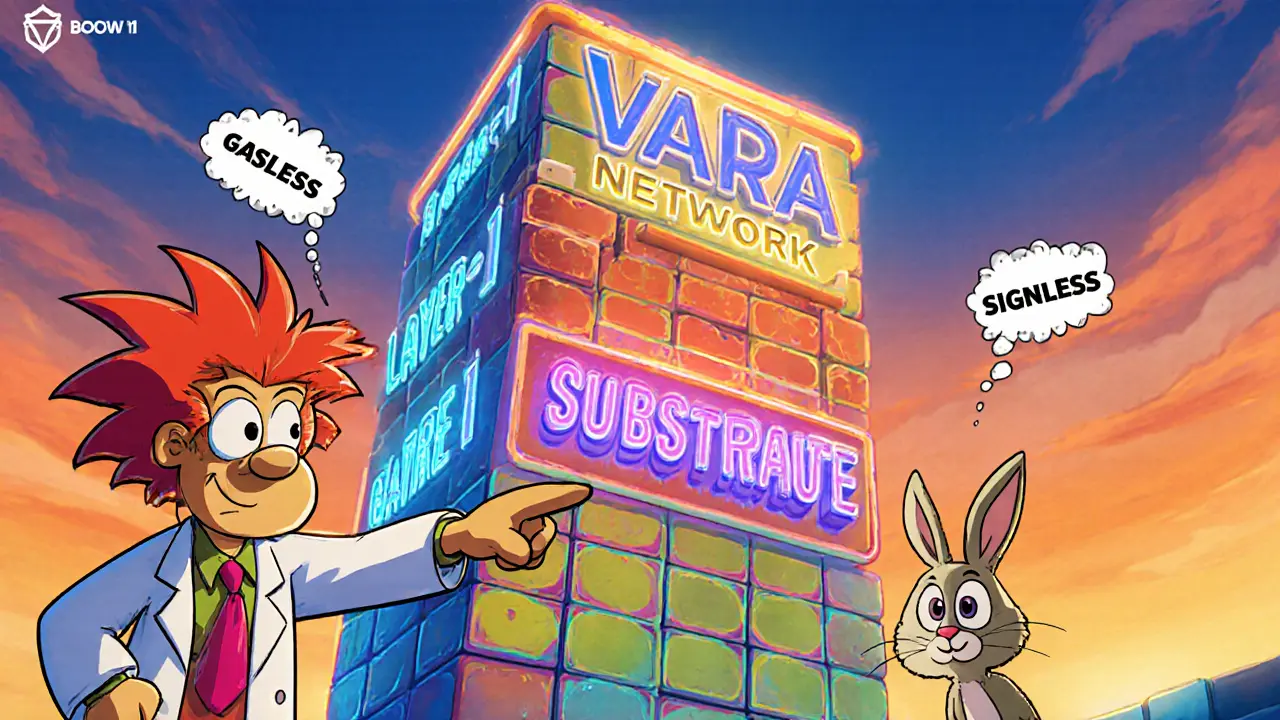VARA Token Price & Supply Calculator
Current Token Metrics
Price Prediction
Analysts project a floor of $0.12 by 2030 (552% upside) and a peak of $0.14 (660% gain).
Note: These projections depend on ecosystem growth and adoption of the gasless model.
Calculate Potential Returns
Projected Returns
VARA Network Overview
Vara Network is a Substrate-based, Proof-of-Stake, Layer-1 blockchain that runs the Gear Protocol. It enables gasless, signless transactions and provides a developer experience similar to classic web development.
Key Features:
- Actor Model: Asynchronous message passing for improved scalability
- Persistent Memory: Permanent contract data storage
- WebAssembly (Wasm): Native support for compiled code
- Gasless & Signless Transactions: No upfront fees for users
- Zero-Knowledge Proofs (ZKPs): Privacy-preserving computations
Ever wondered what Vara Network is and why a growing community of developers is talking about it? In a nutshell, it’s a Layer‑1 blockchain built for Web3 apps that promises gasless, signless transactions and a developer experience that feels more like classic web development. Launched in September2023, Vara aims to solve the scalability, usability, and privacy hurdles that have held many blockchains back. This guide breaks down the platform’s core tech, token economics, ways you can join the ecosystem, and what the future might hold.
Understanding the Core of Vara Network
At its heart, Vara Network is a Substrate‑based, Proof‑of‑Stake, Layer‑1 blockchain that runs the Gear Protocol. Substrate gives Vara a modular foundation, allowing the team to swap out components without rebooting the whole chain. Proof‑of‑Stake (PoS) secures the network by letting token holders stake VARA to become validators or nominators, earning rewards while keeping the ledger honest.
The Gear Protocol is the execution engine that powers smart contracts on Vara. It was born in 2021 and specializes in running WebAssembly (Wasm) code directly in the browser, which means developers can write contracts in familiar languages like Rust or AssemblyScript and have them execute at near‑native speed.
Unlike many blockchains that rely on a single-threaded virtual machine, Vara’s architecture embraces parallelism. Think of it as a kitchen where multiple chefs can work on separate dishes at the same time, instead of one chef handling every order sequentially. This parallel data processing is what gives Vara its deep scalability.
Key Technical Features
Vara distinguishes itself with a handful of innovations that reshape how dApps are built and used.
- Actor Model: Programs and users communicate through “actors,” lightweight agents that send and receive messages securely. This model reduces bottlenecks and makes asynchronous workflows natural.
- Persistent Memory: Contracts can store data forever without worrying about the usual blockchain “state‑bloat” problems. The memory is sandboxed, so each program only sees its own data.
- WebAssembly (Wasm): WebAssembly is a binary instruction format that runs in all modern browsers. By being Wasm‑native, Vara lets developers compile code once and run it anywhere-desktop, mobile, or embedded devices.
- Gasless & Signless Transactions: Users can submit transactions without paying gas fees or providing cryptographic signatures. The network covers execution costs, which dramatically lowers friction for end‑users.
- Zero‑Knowledge Proofs (ZKPs): Zero‑knowledge proof technology lets a party prove something is true without revealing the underlying data. In practice, this boosts privacy for identity verification, supply‑chain tracking, and confidential finance.
These pieces fit together to enable what the team calls “autonomous programs.” A contract can schedule future actions, trigger off‑chain computations via built‑in actors, and run tasks in parallel-all without a developer writing complex boilerplate code.

Tokenomics and Market Snapshot
The native token, VARA (VARA token), fuels every activity on the network. It serves three primary purposes: staking, governance, and paying for optional services that aren’t covered by the gasless model.
| Metric | Value |
|---|---|
| Circulating Supply | 4.43B VARA |
| Total Supply | 10B VARA |
| Current Price | $0.018‑$0.019 USD |
| Market Cap | $12.24M |
| Fully Diluted Valuation | $27.58M |
| 24‑Hour Volume | $584K |
| All‑Time High | $0.1953 (Sep2023) |
| Recent High | $0.1398 (Mar2024) |
After a volatile first year, VARA has settled into a modest price range. Analysts at DigitalCoinPrice project a floor of $0.12 by 2030-a 552% upside from today’s levels-while the peak could touch $0.14, representing a 660% gain. Those numbers hinge heavily on ecosystem growth and continued adoption of the gasless model.
How to Get Involved: Staking, Validators, and the IDEA Portal
If you hold VARA, you can start earning by staking. There are two main roles:
- Validator: You run a node, provide computing power, and secure the chain. Validators earn block rewards and a share of transaction fees.
- Nominator: You delegate your tokens to a trusted validator without running hardware yourself, earning a portion of the validator’s rewards.
Both options require you to lock up a minimum amount of VARA, but the exact thresholds are dynamic, adjusting with network participation levels.
For developers, the IDEA portal is the fastest way to start building. It’s an in‑browser IDE that compiles, tests, and deploys Wasm contracts with a single click. No Docker, no local node setup-just write Rust (or AssemblyScript), hit “Deploy,” and your contract is live on Vara. The portal also auto‑generates the required metadata for actors and persistent memory, shaving hours off the usual learning curve.
Beyond staking, community members can contribute as ambassadors, documentation writers, or even by creating open‑source libraries that plug into the Gear Protocol. The ecosystem currently boasts about 198K members and 271 active ambassadors, suggesting a healthy grassroots effort.

Pros, Cons, and Real‑World Use Cases
What works well:
- Gasless transactions eliminate a major barrier for mainstream users.
- Wasm‑native execution lets developers reuse existing codebases.
- Parallel processing offers true scalability for high‑throughput dApps.
- Zero‑knowledge proofs add privacy without sacrificing performance.
Where it falls short:
- The ecosystem is still small compared to giants like Ethereum or Solana.
- Reliance on off‑chain actors means some trust assumptions remain.
- Gasless model requires the network to subsidize execution, which could be a sustainability risk if usage spikes.
Real‑world pilots are already emerging. A supply‑chain startup used VARA’s ZKP module to verify product provenance without exposing sensitive vendor data. An identity‑verification service leveraged actor‑based messaging to let users prove age eligibility without sending personal documents to a central server. These examples illustrate how Vara’s privacy‑first toolkit can solve problems that traditional blockchains find costly.
Future Outlook and Price Predictions
The road ahead for Vara hinges on two complementary tracks: expanding the dApp ecosystem and solidifying its technical edge. Upcoming roadmap items include:
- Enhanced cross‑chain messaging via the Gear Protocol, enabling VARA‑based contracts to interact with Ethereum, Polkadot, and other ecosystems.
- New built‑in actors for AI‑assisted computation, opening doors for decentralized machine‑learning workloads.
- More robust incentive mechanisms for gasless transactions, potentially shifting from network subsidies to token‑backed rebates.
If these milestones hit on schedule, the token’s price could follow the optimistic forecasts quoted earlier. Even a modest 30% increase in TVL (Total Value Locked) would likely lift the market cap into the $20M‑$30M range, making staking more attractive and fueling a virtuous cycle of adoption.
Of course, cryptocurrency markets remain volatile. Investors should weigh the technical promise against the nascent ecosystem size, and consider diversification across multiple Layer‑1 projects.
Frequently Asked Questions
What is the main difference between Vara Network and Ethereum?
Vara runs WebAssembly natively, offers gasless transactions, and processes messages in parallel using an actor model. Ethereum relies on the Ethereum Virtual Machine (EVM), charges gas for every operation, and processes transactions sequentially within each block.
Can I stake VARA without running a full node?
Yes. By becoming a nominator you delegate your tokens to an existing validator and earn a share of the rewards without managing hardware.
Do gasless transactions mean I never pay any fees?
For most user‑initiated actions, the network covers the execution cost. However, complex or high‑volume operations may require a small fee, typically paid in VARA, to prevent spam.
How does the actor model improve scalability?
Actors communicate via asynchronous messages, allowing many interactions to happen simultaneously. This reduces the need for global state locking and lets the network process many contracts in parallel.
Is VARA a good long‑term investment?
The token’s upside depends on ecosystem growth and the continued relevance of its gasless, privacy‑focused features. If more dApps launch on Vara and the network’s subsidy model proves sustainable, the price could see substantial gains. As always, assess risk and consider diversifying.

This is exactly the kind of innovation Web3 needs! 🚀 Gasless transactions? Parallel execution? I'm so done with paying $50 to mint a JPEG. Vara feels like the future finally arrived. Thank you for this clear breakdown!
While the technical architecture is undeniably sophisticated, one must question the sustainability of a gasless model predicated on perpetual network subsidies. The absence of user-level transaction costs introduces moral hazard, and the long-term viability of such a system remains unproven. One cannot simply eliminate economic incentives and expect rational behavior to persist.
Oh, so now we're treating blockchain like a free lunch buffet? 'Gasless' means someone else is paying-probably you, eventually. And 'parallel processing'? Cool, so now your smart contract can crash in 17 different ways at once. Also, 'persistent memory' sounds like a fancy way of saying 'you just made the blockchain into a giant, slow hard drive.' And don't get me started on ZKPs being used to hide supply chain data-because nothing says 'transparent ledger' like secrecy. 🙄
Let’s be clear: this is not innovation-it’s financial engineering disguised as decentralization. The tokenomics are thinly veiled pump-and-dump mechanics wrapped in academic jargon. A $27M FDV for a chain with under 200K community members? That’s not a network-it’s a speculative vessel. And the fact that you’re calling it ‘autonomous programs’ while relying on off-chain actors? That’s not Web3. That’s just cloud computing with a blockchain sticker on it.
They say it's decentralized but who really controls the validators? I bet it's the same VC firms that funded Solana and Polygon. They're just rebranding their old scams with new buzzwords. Gasless? Yeah right. The network is just printing more VARA to pay for it. You think the price won't crash when the subsidies stop? Wake up.
Actually, this is one of the most thoughtful Layer-1 architectures I've seen in years. The actor model is genius-it’s like Erlang for blockchain. And Wasm-native means you can reuse your existing Rust codebases. No more wrestling with Solidity’s quirks. The gasless model isn’t magic-it’s a UX revolution. And if you’re worried about sustainability, staking rewards will naturally adjust as usage grows. This isn’t hype. It’s engineering.
As someone who’s built on Substrate before, I can confirm: the Gear Protocol’s message-passing architecture is genuinely elegant. The persistent memory model solves the state bloat problem that plagues every other chain. And yes, the IDE portal is a game-changer-no more Docker hell. The real win here is lowering the barrier to entry for non-crypto-native devs. This could bring in millions of web devs who’ve been turned off by EVM complexity. The ecosystem is small now, but the foundation? Solid.
I tried building a simple NFT minting contract on Vara last week. Took me 20 minutes. On Ethereum? Three days and three stack overflows later. The Wasm + actor model is a dream. And no gas fees? My grandma could use this. I’ve been in crypto since 2017 and this is the first time I’ve felt like normal people can actually join in. The price is low now-don’t sleep on it.
Of course it’s ‘gasless’-because the real users are the ones buying the tokens, not the ones using the apps. You think the devs are paying for all those transactions? Please. This is just another way to redistribute wealth from retail to insiders. And ‘zero-knowledge proofs’? That’s just privacy theater for people who don’t understand cryptography. It’s all smoke and mirrors wrapped in Rust.
Gasless? Sure. But who’s paying? The inflationary token supply, of course. And you call this ‘scalable’? Parallel processing only works if the network isn’t saturated-and with a circulating supply of 4.4B tokens, you think they’re not dumping? The ATH was $0.1953… and now it’s $0.018. That’s not a recovery. That’s a corpse on life support.
I’ve been staking VARA for six months. The rewards are steady, the UI is clean, and the community is actually helpful. I didn’t understand the tech at first, but the IDEA portal walked me through it. I’ve never felt so included in a crypto project. It’s not perfect, but it’s the most human blockchain I’ve ever used.
As someone who’s lived in five countries and worked with devs from Nairobi to Seoul, I can tell you this: Vara’s approach to WebAssembly and asynchronous actors isn’t just technically brilliant-it’s culturally significant. It removes the gatekeeping that has dominated blockchain development for a decade. You don’t need a PhD in cryptography to build here. You just need a laptop and curiosity. That’s not innovation-it’s liberation. And the fact that this is happening outside the Silicon Valley echo chamber? That’s the real story.
It’s rare to find a project that actually listens to its users. The team behind Vara has clearly prioritized usability over hype. The gasless model isn’t a gimmick-it’s a commitment to accessibility. And the fact that they’re building for developers, not just speculators, gives me real hope for the future of Web3. Keep going. You’re on the right path.
Let’s not pretend this isn’t a front for a private blockchain. Substrate? Gear Protocol? All open-source? Sure. But who controls the validator set? Who audits the off-chain actors? Who holds the keys to the subsidy pool? This isn’t decentralization-it’s a controlled environment disguised as open. And if you think ZKPs are being used for privacy, you haven’t looked at the code. They’re being used to hide who’s moving the money.
They’re using your data to train AI models. Every ‘autonomous program’ is feeding into a central AI training set. That’s why they’re pushing Wasm so hard-it’s easier to extract behavior patterns. The gasless thing? It’s to get you hooked. Once you’re using it daily, they sell your usage patterns to advertisers. This isn’t Web3. It’s surveillance capitalism with a blockchain logo.